“I am writing to ask for your help, please. I want to know if you know of some books so that I can explain to my children that their dad and I are immigrants. It is difficult at their age to understand what is happening now. My daughter suffered racism from a friend at school. I felt unable to explain and find the right words for her without her being afraid for us. I hope you can help me or guide me to where I can find this information and explain to my children what is happening.”
This mother’s request is not unique, and highlights an issue that we cannot ignore. Negative sentiment towards families who are refugees or have immigrated for other reasons to the United States has always persisted. As early childhood professionals, and in our own personal lives, this is a reality that many of us have seen and dealt with firsthand. These sentiments, or at least the public expression of them, seem to have risen due to recent policy changes affecting some of the children and families we serve, who came to the U.S. from another country. With the rise of these sentiments and the news and discussions that surround them, fear and worry are also on the rise for many children and families.
This fear—of harm, of deportation, or of not knowing how recent changes will affect their families—is on a level akin to trauma, and as such it is something that as early childhood professionals we simply cannot ignore if we are to deliver effective services. Politics completely aside, it is our job as early childhood professionals to create safe, supportive environments for all children and their families that we come across in our work. It is intrinsic to what we do every day, and to the foundation of our work. With that in mind, please use the following resources to guide you in supporting children and their families who have been most affected by recent policy changes.
RESEARCH & RESOURCES
Wisconsin Department of Children & Families (DCF)
Refugee Resources: This webpage offers Wisconsin-specific and national links to resources, programs and agencies supporting refugee children and families.
Wisconsin Department of Health Services (DHS)
Trauma-Informed Care- Resources: These resources will help you to build a foundation of understanding and knowledge to implement trauma-informed care in your work.
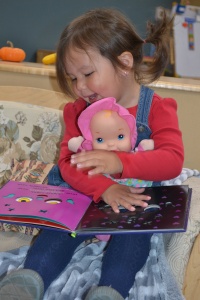 National Association for the Education of Young Children (NAEYC)
National Association for the Education of Young Children (NAEYC)
Voices of Immigrant Parents in Preschool Settings: This article from Young Child discusses insight from the “Children Crossing Borders” project, where more than 100 immigrant parents in five US cities, shared their ideas, hopes and concerns for how their children’s early educators would interact and engage with their children.
What can you do to support and advocate for children, families and educators?: This blog post looks at some of the simple, concrete actions you can take to support and advocate for the children and families that you serve.
Exploration of the Status of Services for Immigrant Families in Early Childhood Education Programs: This report examines the services available to immigrant families in early education and offers guidelines for next steps, to create more supportive, inclusive early education environments.
The Gifts of the Stranger; Learning From Others’ Differences: This article from Young Child looks at how early educators can learn from the differences in the children and families in their care, and by viewing diversity as a strength, become more effective educators.
Teaching Tolerance (A project of the Southern Poverty Law Center)
Immigrant and Refugee Children: A Guide for Educators and School Support Staff: This resource offers basic information to guide your understanding of federal law as it applies to educators sharing information about children and families who are immigrants, and the restrictions surrounding immigration raids, as well as what educators and communities can so to support affected students and families.
Family Preparedness Plan (Plan De Preparacion Familiar): This resource, available in English and Spanish, can be used with immigrant and refugee families so they can feel prepared, and have a plan in place for their family, should something unexpected occur with the parents’ or other family members’ immigration status.
Child Trends
Moving Beyond Trauma: Child Migrants and Refugees in the United States: This report offers a look at some of the traumas child migrants/refugees face, and provides recommendations for policy and practice to better support these children in dealing with this trauma.
Supporting refugee and immigrant children: This blog post provides ways that those supporting children can mitigate childhood trauma that may arise from issues surrounding refugee and immigrant children and their families. As a bonus, this post has an embedded podcast for more information, Episode 1: Three Angles on the Child Refugee Crisis.
The National Child Traumatic Stress Network (NCTSN)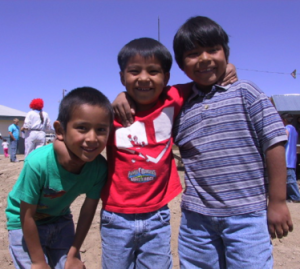
Refugee Trauma Web Page: This page contains multiple resources, tools and guidance for supporting those who deal with trauma related to being a refugee.
Child Welfare Information Gateway
Parental Resilience Web Page: This page offers ideas for supporting children and families to build resilience in the face of trauma and other difficulties.
Helping Immigrant Families Overcome Challenges: This page has a variety of issue-specific resources for working with immigrant children and their families.
Zero to Three
Building Resilience: This resource specifically explores supporting infants and toddlers facing adversity.
American Civil Liberties Union (ACLU)
Know Your Rights: Check out these resources from the ACLU that cover a variety of topics relevant to immigrant and refugee families.
Latino Support Network
Key Resource Guide for The Latino Community, Madison, Dane County, Wisconsin
(Guía de Recursos Claves para la Comunidad Latina, Madison, Condado de Dane, Wisconsin): This guide offers resources specific to those in Madison and/or Dane County, looking for supports and information regarding immigration and related issues.
Catholic Legal Immigration Network, Inc.
Conozca Sus Derechos Guía sobre sus derechos en relación a contacto con oficiales de inmigración o la policía: This Spanish guide provides basic information about immigrant rights when confronted by immigration or law enforcement, as well as preparedness strategies for immigrant families.
Marquette University
Stress Related to Immigration Status in Students: A Brief Guide for Schools: This brief written by Marquette University staff looks at ways immigration can affect students in the classroom, and how staff can support those students and their families.
TRAINING & EVENTS
Supporting Families Together Association (SFTA)
YoungStar Annual Training Calendar (Updated Monthly): This regularly updated list of trainings, primarily focused on early educators, offers various trainings on topics such as resiliency, cultural competency and trauma-informed care, that would be helpful in supporting immigrant and refugee children and families.
Centro Hispano
Immigration Services: Visit or call Centro Hispano in Madison, Wisconsin regarding immigration related consultation, naturalization, permanent residence, DACA (Deferred Action) and family services.
Department of Public Instruction (DPI)
Trauma-Informed Contacts (Training): This list offers several contact options in Wisconsin for setting up or participating in a trauma-informed training.
Substance Abuse and Mental Health Services Administration (SAMHSA)
Cultural Competency for Working with Immigrant Populations (Webinar): Webinar recording and transcript available.
Wisconsin Alliance for Infant Mental Health (WI-AIMH)
2017 Wisconsin Infant and Early Childhood Mental Health Conference: This annual conference offers speakers and sessions promoting social and emotional development in everyday activities for infants, young children, and their families, as well as early intervention and treatment strategies. The 2017 conference will be held June 12-14, 2017 at the Osthoff Resort in Elkhart Lake, WI.
These are only a few of many resources out there. Every child and family we serve is deserving of our unbiased support, compassion and understanding. Let us remember that at the core of how we approach each child, is our collective aim as early childhood professionals to meet them where they are at and support them and their family in whatever way we can to make their early, formative years the best that they can be.
(This article was originally published in the SFTA Q1 2017 Newsletter. Subscribe to our newsletter).
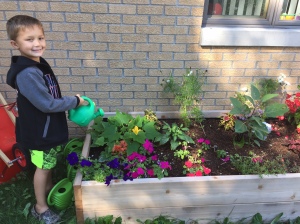 Kids at First Child Care Center in Rice Lake was excited to recently receive their second micro-grant as a YoungStar participating program. Karin Lindau, the Director, worked closely with the program’s Technical Consultant, Lisa Cottrell, on planning how to best use the micro-grant funds to add onto their outdoor play area.
Kids at First Child Care Center in Rice Lake was excited to recently receive their second micro-grant as a YoungStar participating program. Karin Lindau, the Director, worked closely with the program’s Technical Consultant, Lisa Cottrell, on planning how to best use the micro-grant funds to add onto their outdoor play area.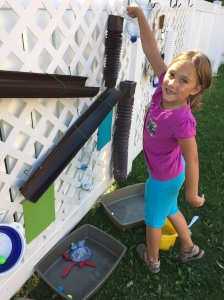 area, and made a list of materials that could be purchased using the micro-grant funds to create those areas. From there, Karin and Lisa worked with Supporting Families Together Association Micro-Grant Program Specialists to purchase or receive reimbursement for the needed materials.
area, and made a list of materials that could be purchased using the micro-grant funds to create those areas. From there, Karin and Lisa worked with Supporting Families Together Association Micro-Grant Program Specialists to purchase or receive reimbursement for the needed materials.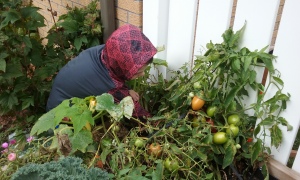 Using creativity, micro-grant funds and donated time from parishioners at the church where the program is housed, they bought lumber and built gardening beds for the kids to plant, harvest and sample seasonal vegetables. High school students volunteered to paint colorful murals on the back of the church shed that faces the playground and the micro-grant funds covered the paint.
Using creativity, micro-grant funds and donated time from parishioners at the church where the program is housed, they bought lumber and built gardening beds for the kids to plant, harvest and sample seasonal vegetables. High school students volunteered to paint colorful murals on the back of the church shed that faces the playground and the micro-grant funds covered the paint. attachments so that kids could funnel, dump and play with water outdoors. A sound wall with various materials and instruments was built for kids to experiment with sound, and a large weaving loom was constructed and woven through with scarves and fabric for sensory and gross motor play. Finally, they added a shaded area for kids to go to read or have quiet time. All of the new outdoor activities were in place for several months before cold weather hit, allowing children and staff to put the areas to use this past summer and fall.
attachments so that kids could funnel, dump and play with water outdoors. A sound wall with various materials and instruments was built for kids to experiment with sound, and a large weaving loom was constructed and woven through with scarves and fabric for sensory and gross motor play. Finally, they added a shaded area for kids to go to read or have quiet time. All of the new outdoor activities were in place for several months before cold weather hit, allowing children and staff to put the areas to use this past summer and fall.
 parents. At the time, the parents decline home visiting from a Family Resource Center of Sheboygan County Parent Educator, and head home with their newborn. When a Parent Educator calls them in a few weeks to follow up, the parents are thrilled to hear from them. Since leaving the hospital, they have questions about their baby’s development, breast-feeding, safe sleep, and a myriad of related topics. The family is provided with additional resources, and decide to participate in
parents. At the time, the parents decline home visiting from a Family Resource Center of Sheboygan County Parent Educator, and head home with their newborn. When a Parent Educator calls them in a few weeks to follow up, the parents are thrilled to hear from them. Since leaving the hospital, they have questions about their baby’s development, breast-feeding, safe sleep, and a myriad of related topics. The family is provided with additional resources, and decide to participate in 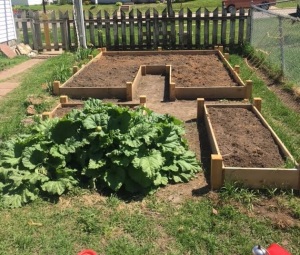 where their food comes from,” said Farm to Early Care & Education Program Coordinator Emily Doblar, adding that the accessibility and low cost of fast food means some children don’t even frequent grocery stores often. Farm to ECE is “really just giving them a sense of community and excitement about healthy food while educating and engaging families makes a huge impact.”
where their food comes from,” said Farm to Early Care & Education Program Coordinator Emily Doblar, adding that the accessibility and low cost of fast food means some children don’t even frequent grocery stores often. Farm to ECE is “really just giving them a sense of community and excitement about healthy food while educating and engaging families makes a huge impact.” The connections Emily is building between early educators and local farming/gardening experts, has helped to overcome some of the unique challenges that ECE programs face in building Farm to ECE into their daily routines. Unlike many WI K-12 schools, child care programs are far more varied in the number of children they have at one time, making it difficult to meet minimum ordering requirements for farms and other fresh food vendors. Some child care programs have very limited budgets to work with, are in areas where it may be unsafe to leave for field trips, or have very little green space or light exposure for a garden. Each program also has their own philosophy that guides the care of the children and may affect how they approach Farm to ECE implementation. Furthermore, there is the need to consider cultural diversity across programs and families and how the Farm to ECE approach might look a little different to meet the varied needs of family and program cultures. For instance, Emily is working with a Hmong preschool teacher familiar with Farm to ECE to engage with Hmong farmers and is working with Community Groundworks to revise the Farm to ECE materials and approach to be a better fit for this purpose. Emily has been able to work with each program from where they are starting and what they need, getting local farmers and other resources in place to support program efforts.
The connections Emily is building between early educators and local farming/gardening experts, has helped to overcome some of the unique challenges that ECE programs face in building Farm to ECE into their daily routines. Unlike many WI K-12 schools, child care programs are far more varied in the number of children they have at one time, making it difficult to meet minimum ordering requirements for farms and other fresh food vendors. Some child care programs have very limited budgets to work with, are in areas where it may be unsafe to leave for field trips, or have very little green space or light exposure for a garden. Each program also has their own philosophy that guides the care of the children and may affect how they approach Farm to ECE implementation. Furthermore, there is the need to consider cultural diversity across programs and families and how the Farm to ECE approach might look a little different to meet the varied needs of family and program cultures. For instance, Emily is working with a Hmong preschool teacher familiar with Farm to ECE to engage with Hmong farmers and is working with Community Groundworks to revise the Farm to ECE materials and approach to be a better fit for this purpose. Emily has been able to work with each program from where they are starting and what they need, getting local farmers and other resources in place to support program efforts.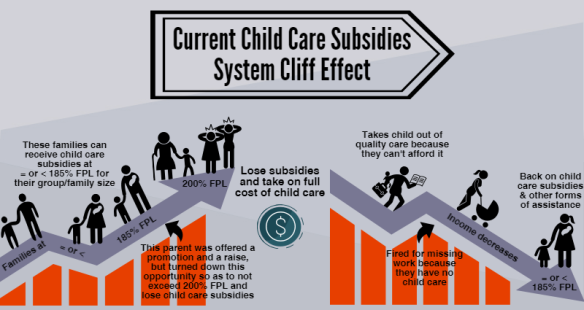 (
( National Association for the Education of Young Children (NAEYC)
National Association for the Education of Young Children (NAEYC)
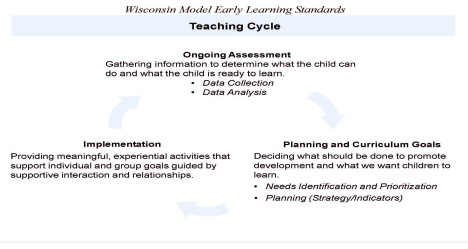 be available to providers in both English and Spanish by December 2016), that delves deeper into The Teaching Cycle, breaking down its components for providers to implement in their child care programs. This training, Individual Learning: Planning Experiences and Documenting Development, is a continuation of The Teaching Cycle process as identified in the
be available to providers in both English and Spanish by December 2016), that delves deeper into The Teaching Cycle, breaking down its components for providers to implement in their child care programs. This training, Individual Learning: Planning Experiences and Documenting Development, is a continuation of The Teaching Cycle process as identified in the 
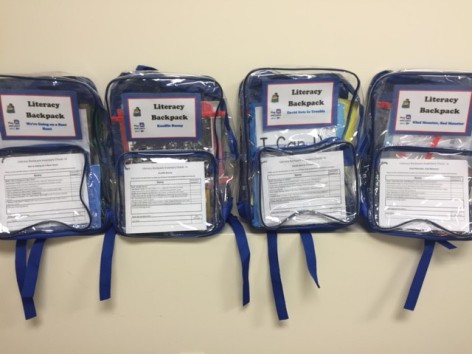 Engagement Specialist, Ruth created a series of Literacy Backpacks that parents participating in
Engagement Specialist, Ruth created a series of Literacy Backpacks that parents participating in 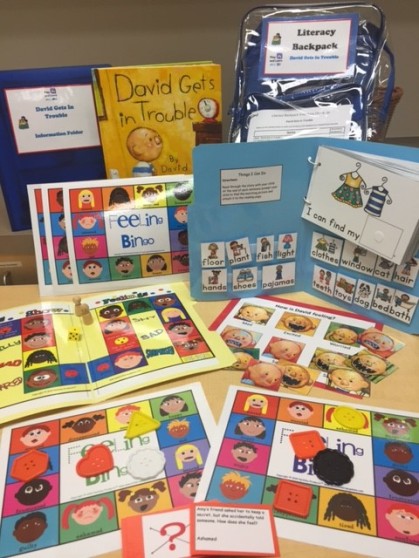
 their parents incorporating PIWI methodology. These cafés will take place for an hour and a half once a week from April through May of 2016. Cafés are currently still in the planning stages in terms of what the structure will look like, but recruitment is already in the works. The agency plans to take café invitations directly into birthing centers at local hospitals, so that new parents can easily access this opportunity. Parents will receive yet-to-be-determined incentives for attending all six cafés.
their parents incorporating PIWI methodology. These cafés will take place for an hour and a half once a week from April through May of 2016. Cafés are currently still in the planning stages in terms of what the structure will look like, but recruitment is already in the works. The agency plans to take café invitations directly into birthing centers at local hospitals, so that new parents can easily access this opportunity. Parents will receive yet-to-be-determined incentives for attending all six cafés.